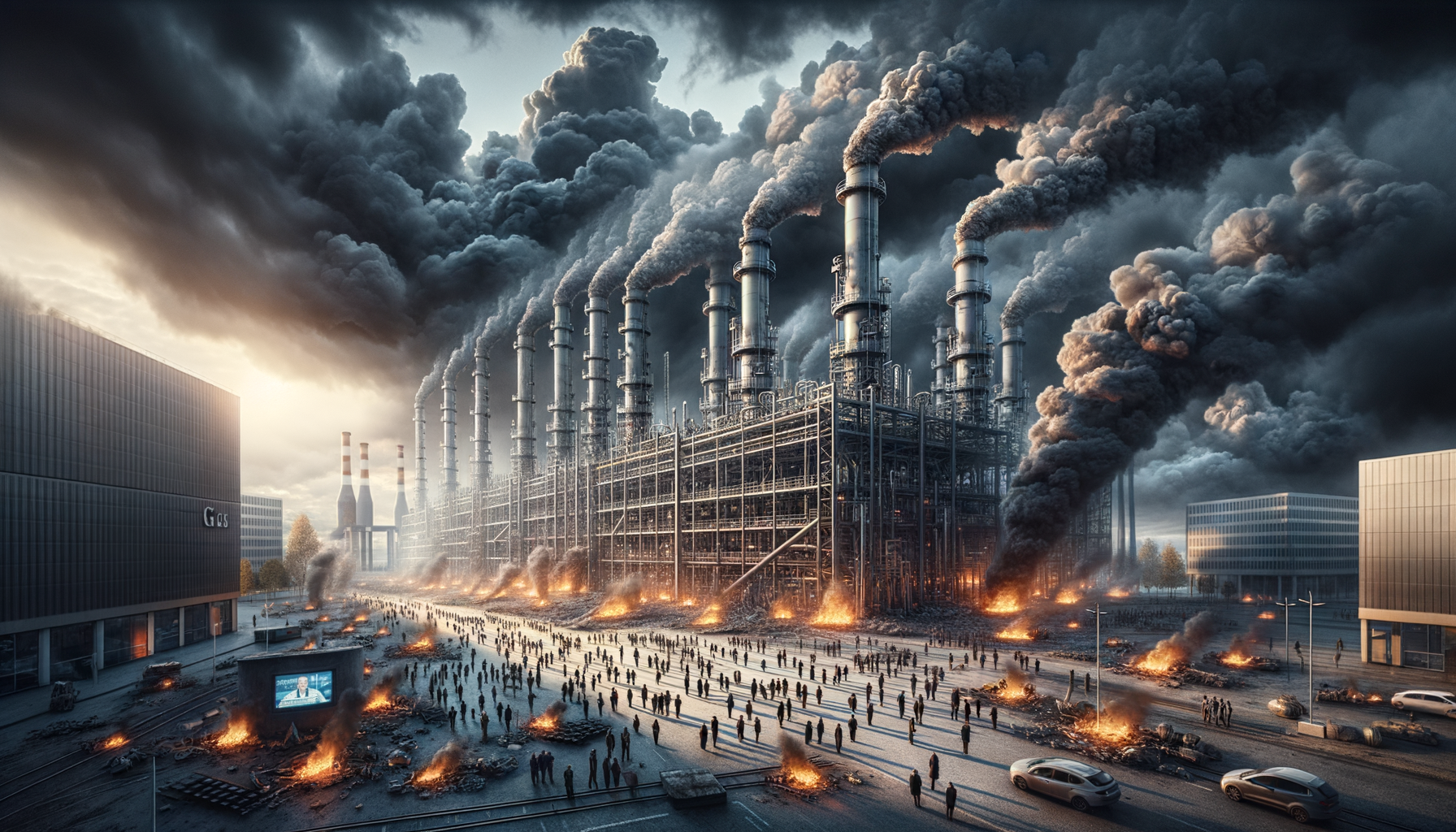# Recent Attack by Russia on Ukrainian Gas Facility and Its Consequences for Europe: Pricing and Gas Availability
The recent attack by Russia on a Ukrainian gas facility has sent ripples across Europe, stirring concerns over gas pricing and availability. This development not only underscores the geopolitical tensions between Russia and Ukraine but also has profound implications for Europe’s energy landscape.
## The Incident: Ukraine Gas Facility Under Attack
On a seemingly ordinary day in 2023, a sudden strike on a Ukrainian gas facility became headline news. The damage inflicted on the infrastructure was extensive, leading to an immediate halt in gas supply from the impacted facility. This event is the latest chapter in the ongoing conflict between Russia and Ukraine, a conflict that has now gripped Europe by its energy lifeline. Historically, Europe has been heavily reliant on gas supplies from Russia and Ukraine due to geographical proximity and established pipelines. This dependence has always been a double-edged sword, as geopolitical disturbances can lead to severe disruptions. The recent attack, therefore, has not just caused immediate infrastructural damage but also sent shockwaves across European energy markets, reigniting concerns about energy security and stability.
## Immediate Impact: Gas Prices Soar
### European Gas Prices 2023: Unease and Uncertainty
The timing of this attack is particularly alarming as Europe was already grappling with numerous energy challenges, including transitioning to greener sources and dealing with an ongoing energy crisis post-pandemic. With the damage to the Ukrainian facility, European gas prices have seen an immediate spike, pushing the region into a state of anxiety. Market analysts have rapidly adjusted their forecasts, and consumers across the board are feeling the squeeze as energy bills skyrocket. Notably, countries like Germany, Italy, and France, which are significant consumers of Russian and Ukrainian gas, are witnessing some of the steepest price hikes.
### Key Factors Influencing Gas Prices
– **Supply Constraints**: The attack has exacerbated pre-existing supply issues, creating bottlenecks that are hard to overcome in the short term.
– **Geopolitical Tensions**: The ongoing conflict has led to heightened market instability, adding a risk premium to gas prices.
– **Winter Demand**: The seasonal increase in demand for heating purposes is putting additional pressure on prices.
– **Alternate Supply Sources**: Europe’s scramble for alternative sources affects price dynamics, leading to competition and price wars.
## Immediate Consumer Impact: Higher Bills
Consumers across Europe are already experiencing the impact of these heightened gas prices. The higher costs are being passed down from utility companies to the end-users, resulting in significant increases in monthly energy bills. This has led to widespread financial strain, especially among lower and middle-income households. Governments are under immense pressure to mitigate this impact through subsidies or tax relief measures, but such solutions are often temporary and do not address the fundamental issue of supply and demand imbalance.
## Long-term Consequences: Gas Availability and Policy Shifts
### Impact of Russian Attack on European Gas
Beyond immediate price fluctuations, this incident has raised the urgent question of gas availability in Europe. The European Union, heavily reliant on gas supplies from Russia and Ukraine, now faces the herculean task of securing its energy needs amidst an unstable geopolitical landscape. The attack has underscored the vulnerability of relying too heavily on any single source of energy, compelling European nations to rethink their long-term energy strategies.
### Potential Measures and Solutions for Europe
#### Diversification of Supply
One of the most direct ways to mitigate this risk is to diversify supply sources. Europe needs to invest heavily in new infrastructure, such as Liquefied Natural Gas (LNG) terminals. LNG can be imported from more stable regions like the United States, Qatar, and Australia. Such investments, although capital-intensive, can provide a more resilient and flexible supply chain, reducing the continent’s dependence on any single source.
#### Energy Mix Policies
Expedited investment in renewable energy sources like wind, solar, and hydroelectric power is another viable long-term strategy. Diversifying the energy mix will not only reduce reliance on natural gas but also align with Europe’s broader climate goals. Fast-tracking renewable projects and providing incentives for private investments in green technology can create a more balanced and sustainable energy portfolio.
#### Emergency Reserves
Europe must also focus on building and maintaining strategic reserves to manage periods of acute shortage. Utilizing emergency reserves can provide a temporary buffer during crises, allowing time for more permanent solutions to be implemented. Policy frameworks should be strengthened to ensure these reserves are adequately funded and managed.
#### Bilateral Agreements
Securing new bilateral agreements with non-traditional suppliers is crucial. Europe can look towards African nations, Eastern Mediterranean regions, and Central Asian countries for new partnerships. These agreements should be crafted to ensure long-term stability and mutual benefits, offering a diversified source of gas that can act as a safety net in times of crisis.
## Political Responses and Strategic Shifts
The attack has inevitably led to a series of political responses from European leaders. Emergency summits and high-level meetings have been convened to assess the situation and formulate a unified response. There is a growing consensus that energy security needs to be a top priority for the European Union. Strategic frameworks are being developed to ensure a resilient and diversified energy supply chain that can withstand future shocks.
### EU Policy Directions
The European Union is likely to introduce new policy measures aimed at enhancing energy security. These could include stricter regulations on energy reserve levels, incentives for renewable energy investments, and funding for infrastructure projects. There could also be a push for more collaborative efforts among member states, ensuring a unified front in negotiating with external suppliers.
### National-Level Measures
Individual countries are also taking proactive steps to ensure their energy security. For instance, Germany has announced plans to expedite its transition to renewable energy, reducing its dependence on Russian and Ukrainian gas. Italy is negotiating new deals with North African countries for gas supplies, while France is focusing on nuclear energy as a stable alternative. These national measures, combined with EU-wide strategies, aim to create a more robust and secure energy landscape for Europe.
## What Can Consumers Expect?
### Increased Energy Bills
The immediate impact of the Russian attack on the Ukrainian gas facility is most acutely felt by consumers. With gas prices soaring, higher energy bills are almost inevitable unless prices stabilize soon. Governments across Europe are scrambling to introduce measures that can buffer consumers from such price shocks. Some countries are considering subsidies, while others may reduce taxes on energy bills temporarily. However, these are short-term fixes, and the real solution lies in addressing the root causes of the energy crisis.
### Policy Changes
In response to the crisis, several European governments are likely to introduce policy changes aimed at protecting consumers. These could include price caps on energy bills, financial assistance for low-income households, and stricter regulations on energy companies to ensure fair pricing. Additionally, there may be a push for energy conservation programs, encouraging consumers to reduce their energy consumption through various means such as energy-efficient appliances and home insulation improvements.
### Renewable Energy Incentives
The crisis could act as a catalyst for more robust renewable energy policies. Governments are likely to introduce new incentives and subsidies to promote the adoption of sustainable energy sources. This could include financial support for solar panel installations, wind energy projects, and other renewable initiatives. By reducing reliance on natural gas, Europe can not only mitigate the impact of such geopolitical events but also make significant strides towards achieving its climate goals.
## Conclusion: Navigating a Tense Energy Future
The attack on the Ukrainian gas facility is more than a regional conflict; it is a stark reminder of the fragility of Europe’s energy security. The immediate consequences of rising gas prices and uncertainties in availability are daunting. Yet, as Europe contemplates its long-term energy strategies, this incident might catalyze the shift towards a more resilient and diversified energy portfolio. The lessons learned from this crisis will be pivotal in designing a robust and secure energy framework for the future.
Europe stands at a crossroads where geopolitical events are reshaping its energy future. As the dust settles, the lessons learned will be crucial in designing a robust and secure energy framework. By keeping a close eye on this evolving situation, stakeholders and consumers alike can better navigate the complexities of Europe’s energy landscape. The coming months will be crucial in determining how effectively Europe can adapt and emerge stronger from this crisis.
—
This detailed overview captures the complexity and urgency of the recent attack on the Ukrainian gas facility and its far-reaching impacts on Europe. By addressing the immediate consequences, long-term strategies, and potential consumer impacts, this article provides a comprehensive view of the situation.
**Keywords**: Russia Ukraine gas attack, European gas prices 2023, Impact of Russian attack on European gas, Ukraine gas facility incident, Gas availability in Europe





Leave a Reply